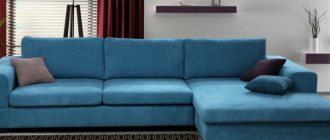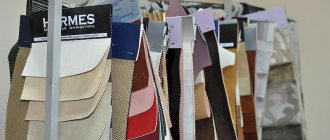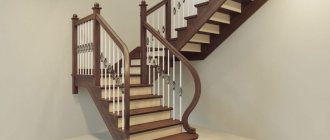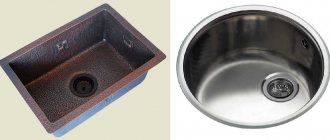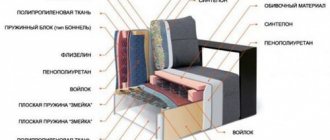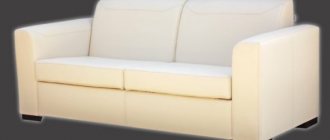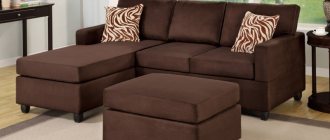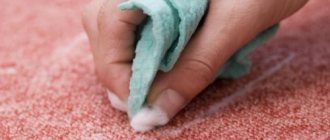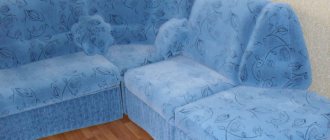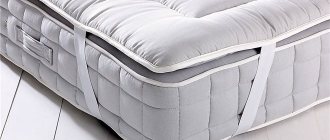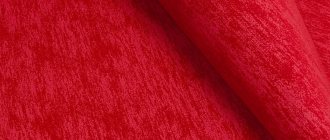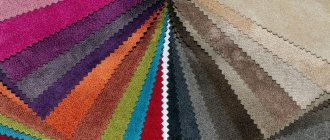When choosing upholstery for upholstered furniture, many buyers pay attention exclusively to the appearance and tactile properties of the material. But these parameters are only the “tip of the iceberg”, under which lies an unobvious layer of technological and operational quality indicators.
We decided to make a series of articles about different types of upholstery materials, in which we will tell you the most important things about the composition, common problems, “relationships” with stains and dry cleaning methods.
In this article we will talk about flock - a popular non-woven material with short fibers that are pleasant to the touch.
A few words about pile
The surface of the upholstery is covered with short soft fibers made of finely chopped colored polyamide or polyester fibers of the same length. Polyamide flock is characterized by increased wear resistance, but does not “like” ultraviolet rays (it burns out). Polyester fibers demonstrate resistance to abrasion, moisture and fading.
Note: in cheap flock, the pile is made from lighter foamed synthetic fibers, which perfectly attract dust.
Read the blog: “Frankly about upholstery. Matting: stylish and unpretentious.”
Criteria, standards and requirements when choosing the type of finish for a sofa
When you need to buy a new sofa or change the upholstery of an old one, consider the criteria for choosing the finishing material:
- Environmental friendliness and compliance with standards. The fewer chemical dyes used in textile production, the better. For a sofa, it is better to choose fabric that has European certificates of quality and safety. This is especially true when choosing furniture for children, teenagers and the elderly.
- Textile composition - it can be synthetic, natural or combined. At the same time, natural materials are not always the best option, especially if the sofa will be actively used. It is most advisable to pay attention to fabric that combines the advantages of natural and artificial components.
- Design and style (pattern, color, presence of prints) - it should go well with the shade and pattern of the wallpaper, type of flooring, and other furniture in the room.
- Comfort – the surface of the sofa should be pleasant to the touch.
- Wear resistance, which allows textiles not to sag under heavy weight, is expressed in tensile strength and tensile strength.
- Density – options with a density of 200 g/m2 or more are suitable for the sofa. The denser the better, as wear resistance increases, which means the cost ultimately decreases.
- Abrasion resistance - this indicator is checked using a special test by the manufacturer. Consult with an employee of the company where you are going to buy a sofa or reupholster it. Ask what the indicator is for a particular fabric - textiles must withstand at least 20 thousand friction cycles before the first signs of damage to integrity appear.
- Resistance to ultraviolet rays and fading - this should be indicated in the furniture passport. The optimal color fastness index is 3.5.
- Resistant to high temperatures and fire. This is an important factor, especially if the furniture will be in the kitchen, near the fireplace, or in the children's room. The safest textiles in this regard are labeled as the first of five classes.
- Air permeability is important when the furniture is subject to heavy loads. If the fabric does not allow air to pass through well, it may simply “come apart at the seams.”
- Impregnation, which increases the moisture-resistant and dirt-repellent properties of the upholstery, is a factor that ensures the furniture has minimal maintenance requirements. The most reliable preparations for impregnation are Teflon and Scotchgard. If textiles are processed with them, this will be indicated in the product passport, other technical document and on the label.
- Can be cleaned with a variety of household chemicals. This issue must be clarified with a store consultant, since not every fabric can be exposed to chemicals.
If the fabric meets the listed characteristics, then it is of high quality, safe and manufactured in accordance with GOST standards.
How and on what the pile is attached
The fibers are glued onto a thick textile backing using glue. High-quality flock uses acrylic glue that is relatively safe for health.
The “correct” flock backing should contain natural and synthetic fibers in a ratio of 35 to 65 (35% cotton and 65% synthetics). A low-quality base consists entirely of cheap synthetics.
How to check: if the skin quickly sweats upon contact with the surface of a sofa or chair, it means the base is made of artificial material. High-quality flock does not cause this “side” effect.
The technology for creating a fleecy layer is called flocking. The villi are treated (activated) with electrolyte and applied to the adhesive layer perpendicular to the base using an electrostatic field, which is created by a special device - a flocker.
Between the flock and the filler there must be a protective textile layer that prevents contact between the materials. In our case, there was no interlayer, so after dry cleaning, stains appeared on the upholstery. Order on-site dry cleaning of a sofa or armchair with flock upholstery in St. Petersburg and the Leningrad region
Velor for finishing a sofa – to choose or not?
Velor in appearance and when touched is similar to flock or velvet. There are differences between these types of textiles, we will write about them below. In the meantime, let's look at the manufacturing features, composition, pros and cons of velor, evaluating it as a material that can potentially be used for upholstery of upholstered furniture.
Typically, velor is made by weaving threads and fibers together or joining together a series of knitted loops. Velor fabrics can be classified depending on several characteristics:
The material of the threads from which the fabric is made is the most commonly used natural cotton and wool threads; wool is taken both pure and mixed. Recently, synthetic components have also begun to be used in the manufacture of velor, but synthetics are still quite rare in velor fabrics.
Method of weaving fabric threads:
- Knitted fabric.
- Velor with plain weave.
- Moire fabric is a combination of fibers of different lengths and directions.
- Velor with a jacquard pattern, which is obtained by weaving one type of thread or adding lurex or silk threads to the composition.
Painting method:
- Smooth-dyed velor (the thread itself or the finished material is processed).
- Printed - patterns and drawings are applied (stuffed, imprinted) on top of the material using various cliches.
There are several types of velor depending on its purpose - curtains, furniture, automobiles. Manufacturers use furniture velor for upholstery of sofas, armchairs, and couches, since its characteristics - strength, density, elasticity - can extend the service life of products.
Distinctive features of velor
, which make it a suitable option for finishing:
- Excellent appearance, softness - the use of this fabric will create coziness in the room.
- Eco-friendly, hypoallergenic.
- Variety of colors, textures and patterns. The sofa will fit into any interior if you choose a shade that matches the main color scheme of the room.
- Strength, wear resistance, resistance to treatment with cleaning powders and special solutions. Velor tolerates care well with brushes and a vacuum cleaner.
Disadvantages of velor
as a material for finishing a sofa:
- Stubborn stains (coffee, wine, berries) are difficult to remove from fabric, so careful handling is required.
- As in the case of flock, the pile wears out over time, but this is a drawback of all such materials.
- The price is higher than that of flock, since fabrics made from natural ingredients are expensive.
A few words about formaldehyde in glue
Any adhesive in flock contains formaldehyde (hazard class 2), a certain part of which is released into the air. The main question is the amount of freely released gas, which directly depends on the quality of the glue.
Cheap upholstery from Chinese “no name” manufacturers usually uses a toxic adhesive composition. In this case, the level of formaldehyde released may exceed the norm (1000 μg/g according to GOST R 50729-95) several times. Flock from certified manufacturers (for example, Microfibres) also contains formaldehyde, but its emission level is significantly less than the norm (5-10 times).
What is flock
Flock is a non-woven universal textile that has a characteristic pile on the front side.
In appearance, quality and functionality it is similar to velor, but is cheaper. The canvas includes two parts. The first is a dense load-bearing base, the second is pile. The material production process includes three stages:
- pile cutting;
- coloring (sometimes done before cutting). Flock can be dyed well with any shades;
- fabric processing. In turn, it includes activation of the pile, spraying and fixing. At the end, the material is treated with a special compound that helps improve its aesthetic and functional characteristics.
About the “relationship” with pollution
Flock upholstery is easily cleaned from fresh stains of various origins, many of which can be removed by extraction even without the use of specialized detergents. Without regular maintenance, the flock will inevitably begin to become covered with sweat and grease stains, which will “establish” a close relationship with the adhesive layer and firmly adhere to the surface of the sofa or chair. Traces of sweat and grease are especially noticeable on light-colored flock.
A flock sofa before dry cleaning (in the photo in the preview of the article is the same sofa, only after dry cleaning)
Reviews
The reviews of flock furniture fabric that we have collected for you will help you get an idea of the advantages and disadvantages of upholstery - learn from the experience of other buyers!
Olga Petrovna “This is truly one of the most practical upholstery fabrics - easy to clean and lasts a long time. Our sofa has been standing for three years and still has not suffered any damage. Any dirt can be removed immediately, the color does not change over time, although the furniture is used very actively.”
Alina “This fabric attracted my attention when choosing reupholstery due to its price - the cost is really very low. I want to speak exclusively “for” the purchase, since the material of the furniture does not get dirty or cling, although there is a small child and a cat at home. There is still one small drawback - over several years, the upholstery on furniture wears out in places of greatest contact.”
You can leave your review at the bottom of the page. Finally, we have collected useful tips on caring for furniture upholstery - they will definitely come in handy after purchase.
Compare additionally with microfiber fabric for furniture, maybe it will suit you better.
About flock cleaning methods
Flock can be cleaned with water at room temperature or higher (up to 100 degrees) with the addition of weakly concentrated alkaline agents. Old stains are removed with enzyme formulations (enzymes enhance the effect of the cleaning agent.
Important: if the flock is in contact with the filler (there is no protective backing under the upholstery), streaks may appear on the material after water cleaning. An example of stains from yellowed foam rubber is in our photo.
After contact with water, foam rubber can “manifest” itself in the form of yellow stains on the upholstery
What not to use:
► Hot steam with a temperature above 125-135 degrees – makes the glue plastic
► Organic solvents, including those high in D-limonene (derived from citrus skins)
► Hard straightening brushes – can remove lint and leave bald spots
► Gasoline and alcohol-containing products soften the glue.
Important: when cleaning flock upholstery, it is important to be extremely careful, both chemically and mechanically. The material should not be actively rubbed or “watered” with large amounts of water (consumption during water cleaning should be moderate). Any cleaning product must be tested on an inconspicuous surface before application.
Care
The material is considered not picky and easy to clean. In some cases, it is possible to do without washing - the dry method is sufficient. Furniture fabric can be refreshed with a soap solution, or rather with thick foam, the remains of which are removed with a vacuum cleaner. Lemon juice will help remove food stains. It is diluted with water, the stain is treated, and then removed with a sponge. Dishwashing gel will help remove grease stains. The product is foamed, passed over the stain, and soaked with a dry cloth or paper towel.
If we are talking about flock clothing, then washing in a washing machine is allowed. A mode for synthetics and a gentle detergent are suitable. The product cannot be wrung out, and the item must be turned inside out before washing.
It is important to remember some taboos for flocked fabrics:
- Dry cleaning is prohibited unless otherwise specified by the manufacturer;
- cleaning with solvents and alcohol-containing compounds is unacceptable;
- Before cleaning with foam or soap solution, be sure to remove dust using a dry method: with a brush, vacuum cleaner, etc.;
- It is prohibited to dry clothes and other products made from flocked fabrics on heating devices.
Dear readers of the Tkan.Club website, if you still have questions on this topic, we will be happy to answer them. Leave your reviews, comments, share stories if you have dealt with this material! Your life experience may be useful to other readers.
